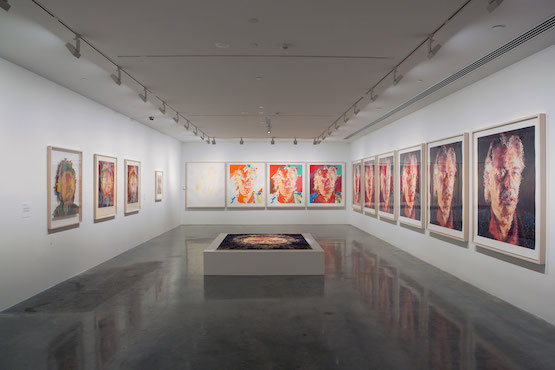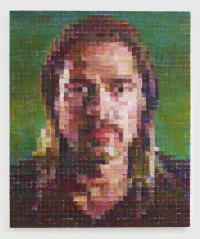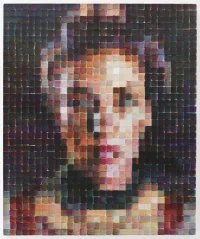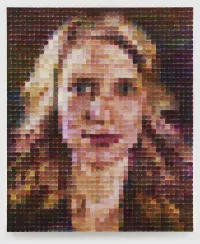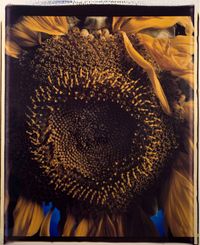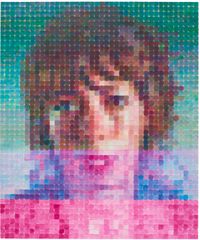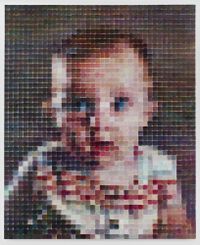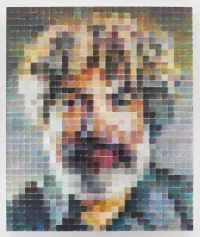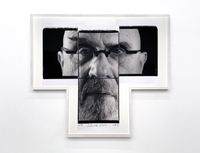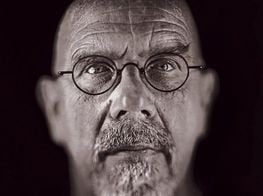Terrie Sultan

Terrie Sultan is the energetic curator behind the incredibly popular series of exhibitions Chuck Close: Prints, Process and Collaboration
. First staged in Houston in 2003, the show has now been exhibited over twenty times around the world. The exhibition changes each time, reflecting the fact that Close continues to make prints and push the medium even further.
The latest iteration of the exhibition, to show at the harbourside Museum of Contemporary Art in Sydney, also includes two important loans from the National Gallery of Australia. Sultan is especially excited to see the 1972 mezzotint Keith join the exhibition – a key work which explains Close’s decision to start exposing the grid used in making his paintings and prints.
Sultan has clearly spent a lot of time talking about Close and his work. Her anecdotes have the polish of several retellings but her sheer enthusiasm for the work is genuine and infectious. It’s a sign of the strength of her relationship with Close that she continues to be a part of these exhibitions despite her other work commitments, which five years ago saw her take on the directorship of the Parrish Art Museum on New York’s Long Island. She has been kept busy with the construction of the museum’s striking and light filled new building but as she tells it, when it comes to Chuck Close she just can’t help getting involved.
When did you first get to know Chuck Close and where were you working on at the time?
I was the curator of contemporary art at the Corcoran Gallery of Art from 1988 to 2000. Somewhere around 1993 or 1994 I started thinking about a series of artists I would really like to know more about and work with – Chuck was one of them. I’d always been really fascinated by his work … I went over [to his studio in New York] and we started talking. Chuck is very gregarious and he likes to talk.
He hadn’t had a survey exhibition in an American museum since the big one in the 1980s at the Walker Art Centre … He said ‘You know, I’m talking to both the Met and the Modern so probably that’s not going to work out for you at the Corcoran, but I can tell that we’re simpatico so let’s just continue to get to know each other and we’ll figure out a project to do some day.’
So about once every couple of months I’d go to the studio and we’d just sit around and talk. And one day this linoleum print of Alex Katz was on the wall – all of it like you see it now [in the exhibition], with the state proofs above and the progressives below. And I was staring at it and staring at it and finally I said ‘I don’t know what I’m looking at’ … He explained everything to me about how the print was made and why he showed it that way … I said I was surprised that one of the major print curators in one of our big museums hadn’t approached him with the idea of doing a show on the process of making the prints because it’s so involved and so amazing, and he said ‘That’s the show for us to do together.’ I said ‘But I’m not a print curator’ and he said ‘Good, so much the better.’
We started working on it and it took us three years to put the project together and we opened it in Houston in 2003.
Chuck Close: Prints, Process and Collaboration, Exhibition view, Museum of Contemporary Art, Sydney, 2014. Courtesy the artist and Pace Gallery, New York. Photograph: Jess Maurer
So when you were standing in his studio looking at the portrait of Alex, do you remember what it was about the work that first captured you?
Well, what captured me about it, first of all, was the very long and involved narrative that went with it. Everything with Chuck is a long story. But what really struck me was that, understanding exactly how it was made and exactly what had happened, it still looked like magic … That’s basically true of every print. You see everything – you see the print matrixes, you see the progressives, you see the state proofs – but what it doesn’t tell you is what it is about this man’s brain and eye [or] how he knows that by going through these steps that it’s going to turn out this way.
It is still quite unusual to see an exhibition like this where you get to see the artist’s process in this depth.
I don’t know anybody that does this. As a curator I have always been very interested in decision making and process. For me the first question that I ask myself when I see an artist I’d like to work with is ‘How did he or she ever think of that? How did they do that? And why?’
Chuck Close: Prints, Process and Collaboration, Exhibition view, Museum of Contemporary Art, Sydney, 2014. Courtesy the artist and Pace Gallery, New York. Photograph: Jess Maurer
I think if I’m asking myself that question then there must be other people who are too, but most artists are not willing to tell you … I have worked with artists where I’ve walked into the studio and everything’s been turned to the wall. But for Chuck, he is all about process. What he does is he makes marks, every day, all day. He translates information by making a mark, and if he can explain how it’s done he’s happy to do it.
He doesn’t feel like it takes anything away from your appreciation of the object … If he tells me how to pull a rabbit out of a hat, chances are I’m not going to be able to do it. There’s still a sense of magic there. I think that’s why to me, after all of these years of working with this material – and of course we’ve updated it over the course of 10 years – every day is a revelation.
The show has changed considerably since 2003. What’s different about the Australian exhibition?
The two most important things about being here, which have made both Chuck and I so excited, is the opportunity to reunite all of the material for the Keith mezzotint, which is so key to his entire career in printmaking, with the show. We had in the show one of the finished prints, and a few little smatterings of proofs that he had kept, but what the National Gallery of Australia has [loaned] are all the major progressives which show how that print was made. No one has seen it. And then getting Bob, which was from the series that the original Keith painting was from also, it’s a beautiful way to set up the whole story.
Over the past decade Close has also continued to make prints. Are there new works in this show?
Well, we added the Roy pulp paper, we added all the tapestries, the felt handstamps, the watercolour digital prints, and the Japanese scribble etching, the anamorphic. So there are a lot of new prints. And the new self-portrait, the woodcut, which barely got finished in time to come to Australia.
Chuck Close: Prints, Process and Collaboration, Exhibition view, Museum of Contemporary Art, Sydney 2014. Courtesy the artist and Pace Gallery, New York. Photograph: Jess Maurer
There’s an interesting dynamic between the painting side of his practice and printmaking. How do you see that interplay?
I’ll just quote Chuck when he told me that almost every significant breakthrough in his paintings has been as a direct result of something that he’s learned in making a print. So if you look at Bob and you see that face, you don’t see a grid anywhere, it’s all been obliterated even though he starts with a photograph, puts the mylar over it in a grid and basically translates one square of information to the canvas.
When he made [the mezzotint] Keith, which he made a couple of years after he finished those series of eight paintings that Bob was one of, the plate broke down and the grid came through. And when they printed it he saw the grid and he said to himself ‘Henceforth I’m just going to let it all hang out there and let everybody see the grid.’ You can see that made a huge change in the way that he made his paintings.
How do you describe your relationship with Close these days? You obviously have a lot on your plate as director of the Parrish Art Museum, but you’re here in Sydney and giving a talk, and you were saying before that you also talk to the printmakers.
I don’t really know how this happened. I’m just so entranced by his creative process. He’s certainly not the only artist I’ve ever worked with but as a curator, what I really like to do is explore aspects of people’s work that are underknown or underappreciated. So in 2003, everyone was lauding Chuck as one of the greatest painters of all time, which he is, but no one was looking at his prints and they’re such an important part of his practice.
Then two years ago, I was sitting in his studio and said ‘You know, no one has done a retrospective of your work as a photographer, even though everything starts with a photograph. And photographs have been included in all of your major surveys. But nobody’s looked at the trajectory of the work in photography.’ So now I’m doing that. And I’m not supposed to be organising shows but I just can’t help myself.—[O]
Chuck Close: Prints, Process and Collaboration, Exhibition view, Museum of Contempoaray Art, Sydney, 2014. Courtesy the artist and Pace Gallery, New York. Photograph: Jess Maurer
'Chuck Close: Prints, Process and Collaboration' is at the Museum of Contemporary Art in Sydney until 15 March 2015. An exhibition of Close's work is also at Utopia in Sydney until 29 November 2014.


